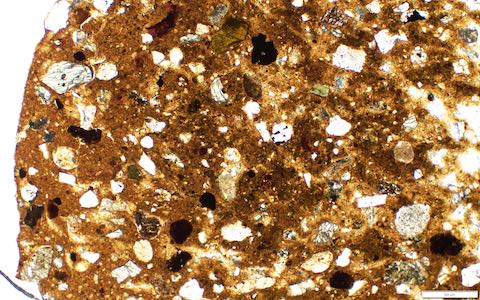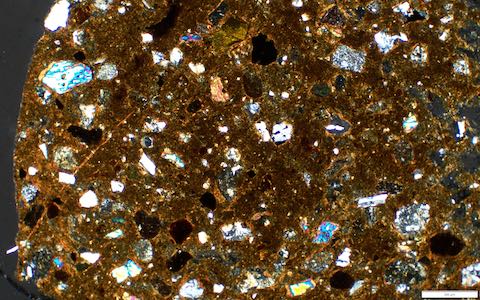

| None (0) | Minor (1) | Few (2) | Common (3) | Frequent (4) | Major (5) | Very Dominant (6) |
| 0% | 0-5% | 5-15% | 15-30 % | 30-50% | 50-70% | 70-100% |
| Name | Cal. | Quartz | Feldspar | Pyroxene | Amphibole | Opaques | Olivine | Biotite | Muscovite | Epidote | Garnet/ Spinel | Ig./Met. Rocks | Sed. Rocks | Grog | Lithics/ Region |
|---|---|---|---|---|---|---|---|---|---|---|---|---|---|---|---|
| tpr459 | 2 | 2 | 3 | 4 | 0 | 3 | 0 | 0 | 0 | 0 | 0 | 4 | 0 | 0 | microphaneritic, microlitic, vitric |
| Madang pyroxenic lithic | 0 | 0 | 2 | 3 | 0 | 2 | 0 | 0 | 0 | 0 | 0 | 3 | 0 | 0 | PNG |
| Slide | Fabric | Possible Origin | Cal. | Quartz | Feldspar | Pyroxene | Amphibole | Opaques | Olivine | Biotite | Muscovite | Epidote | Garnet/ Spinel | Ig./Met. Rocks | Sed. Rocks | Grog | Lithics |
|---|---|---|---|---|---|---|---|---|---|---|---|---|---|---|---|---|---|
| IL_1_91 | tpr459 (Madang pyroxenic lithic) | Bili Bili | 0 | 0 | 3 | 4 | 0 | 2 | 0 | 0 | 0 | 0 | 0 | 4 | 0 | 0 | microphaneritic |


"CAUTION: Section less than 30microns. The pyroxene (10%) is pale green, angular and up to 0.4 mm across. Plagioclase grains are angular and about 0.2 mm across. There are grains containing granular mosaics of quartz, feldspar and opaques up to 0.5 mm across. Opaque minerals are subrounded, and usually skeletal. The clay is a dark brown.